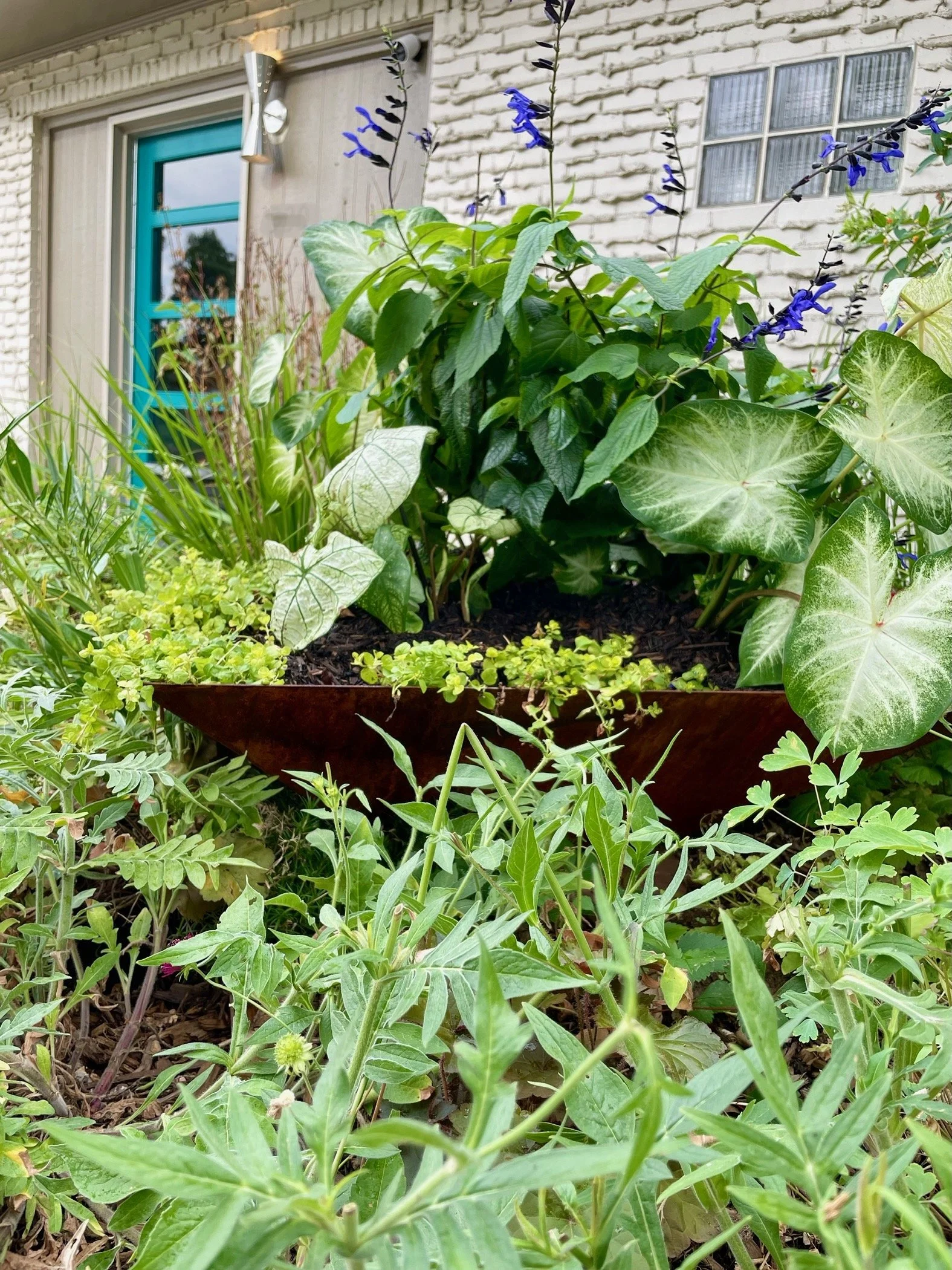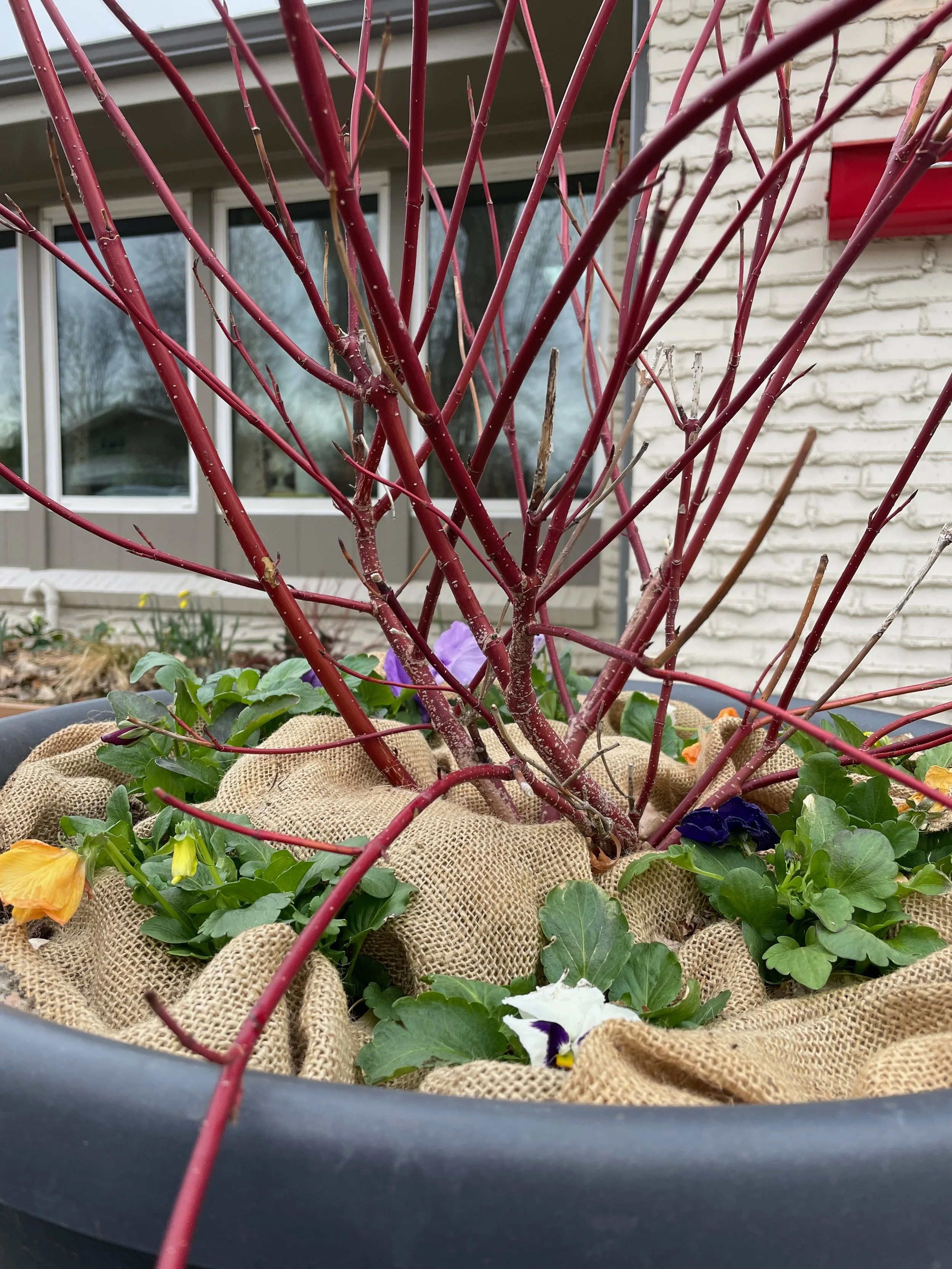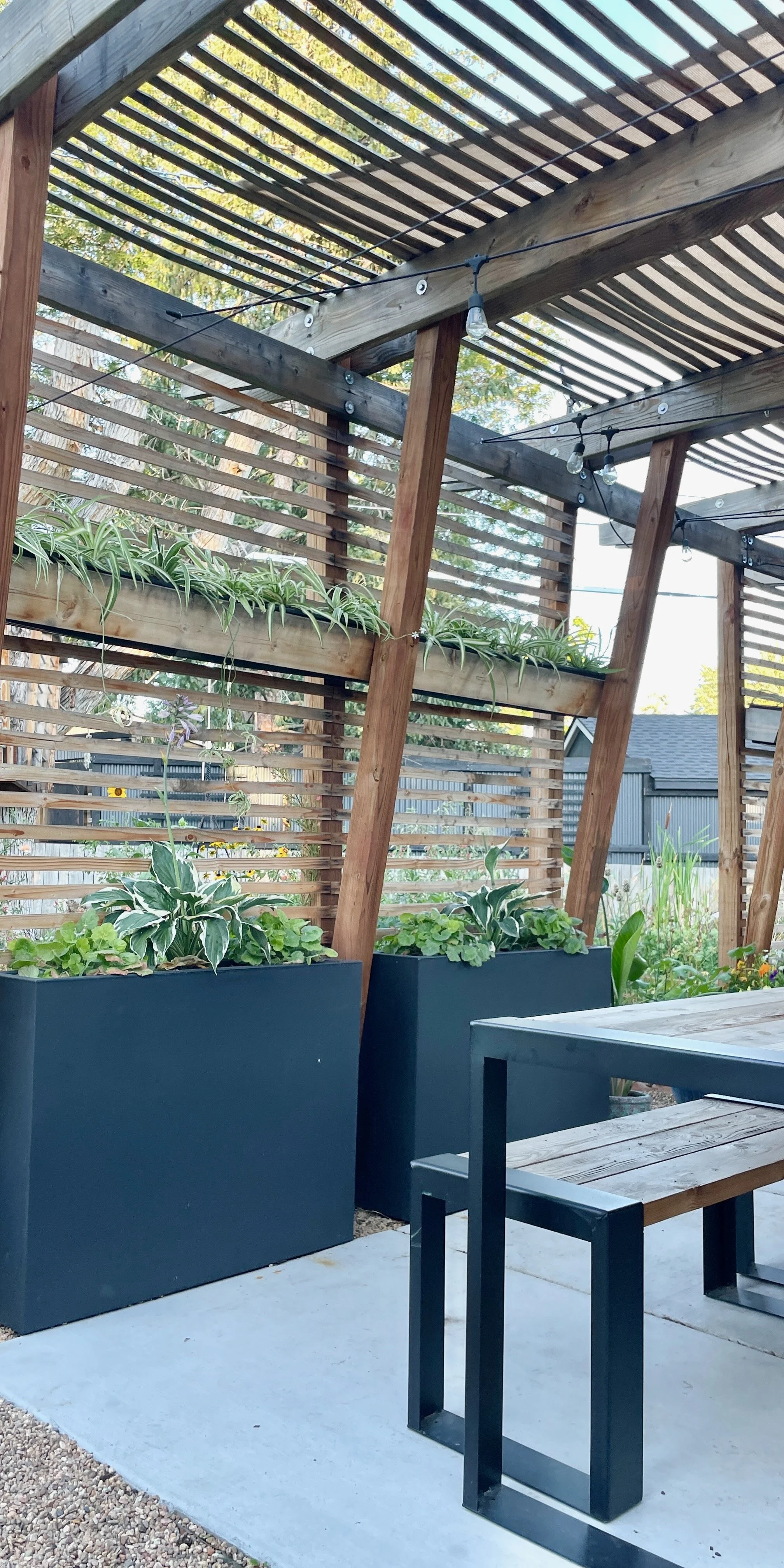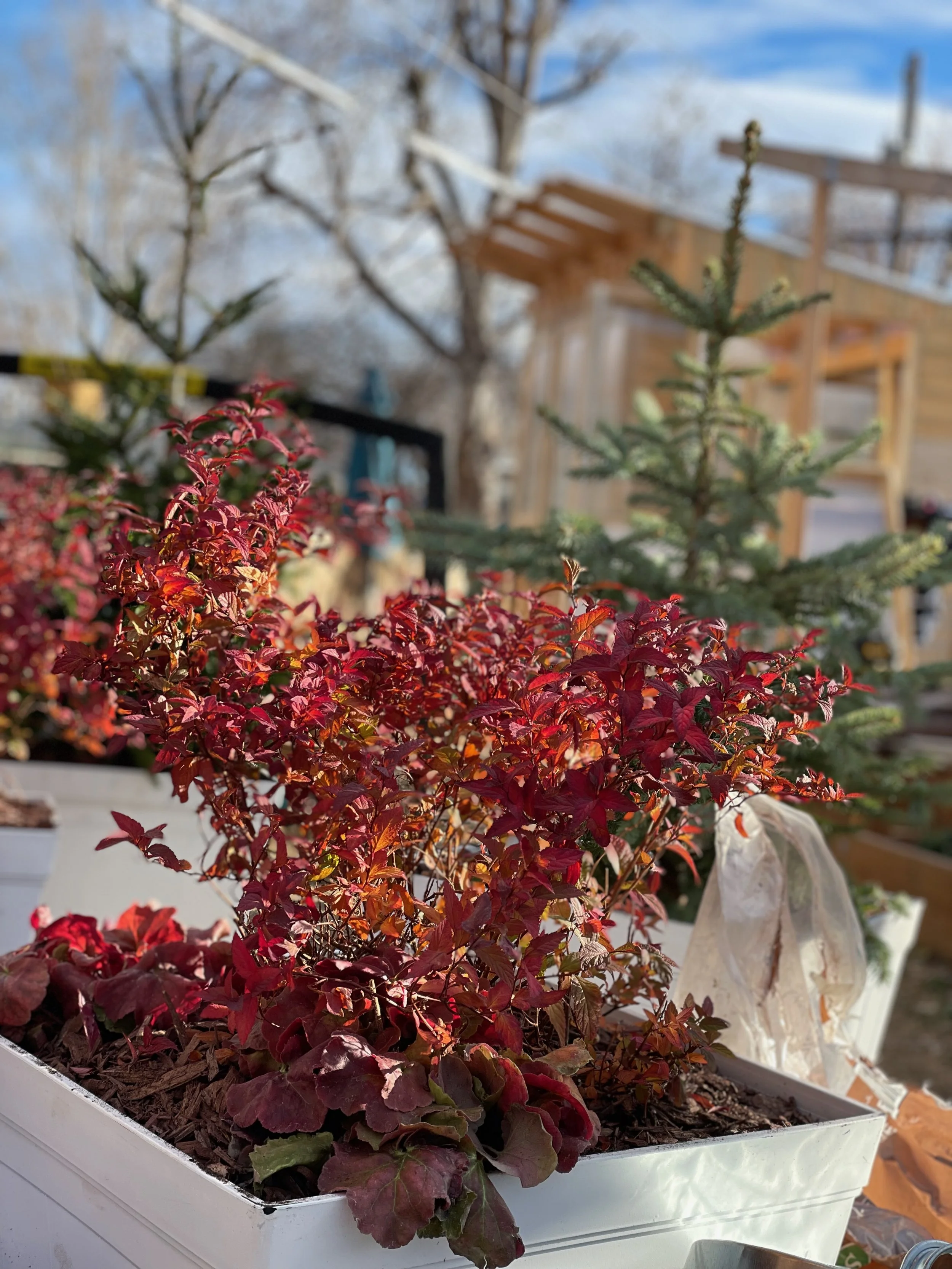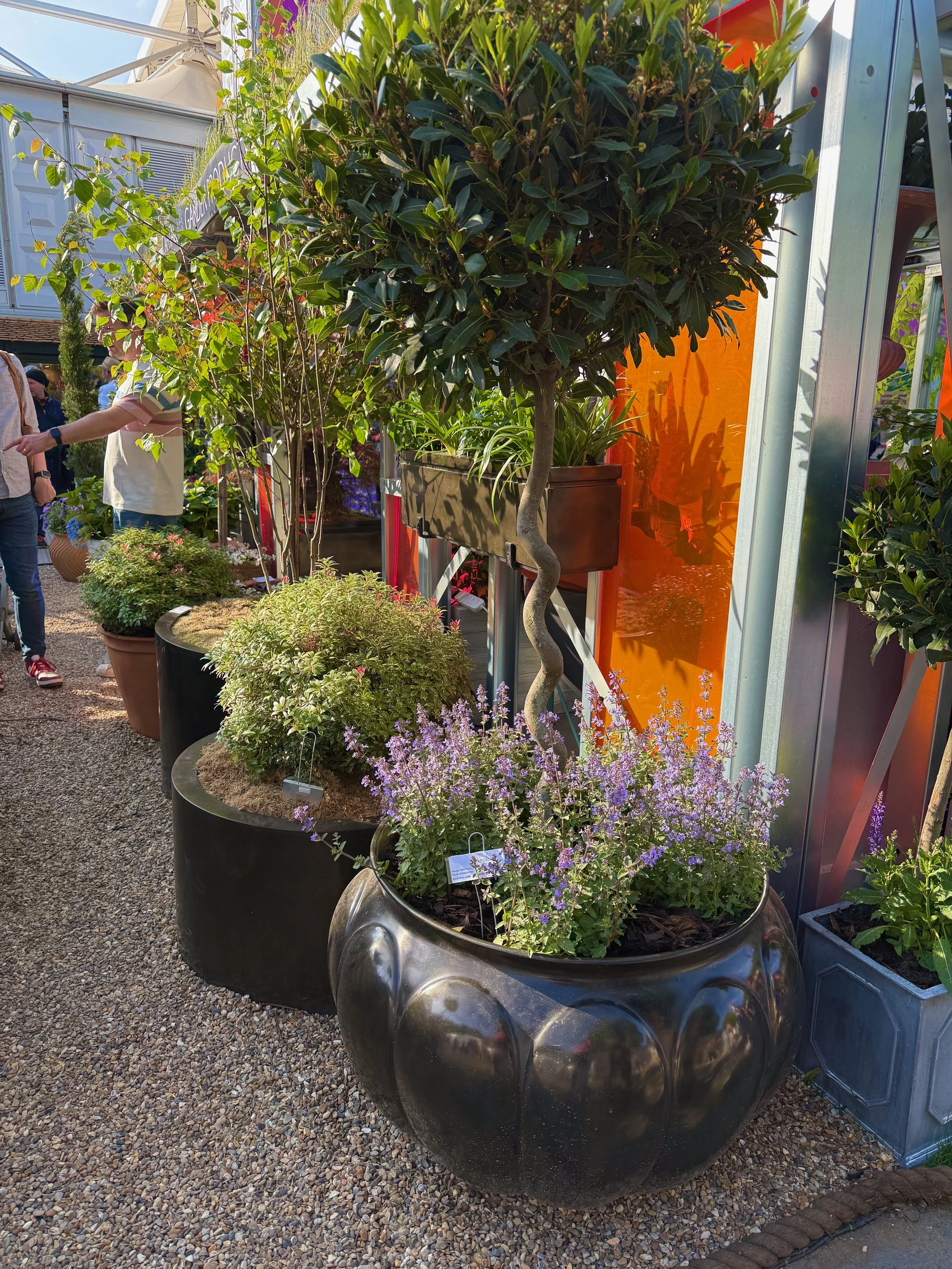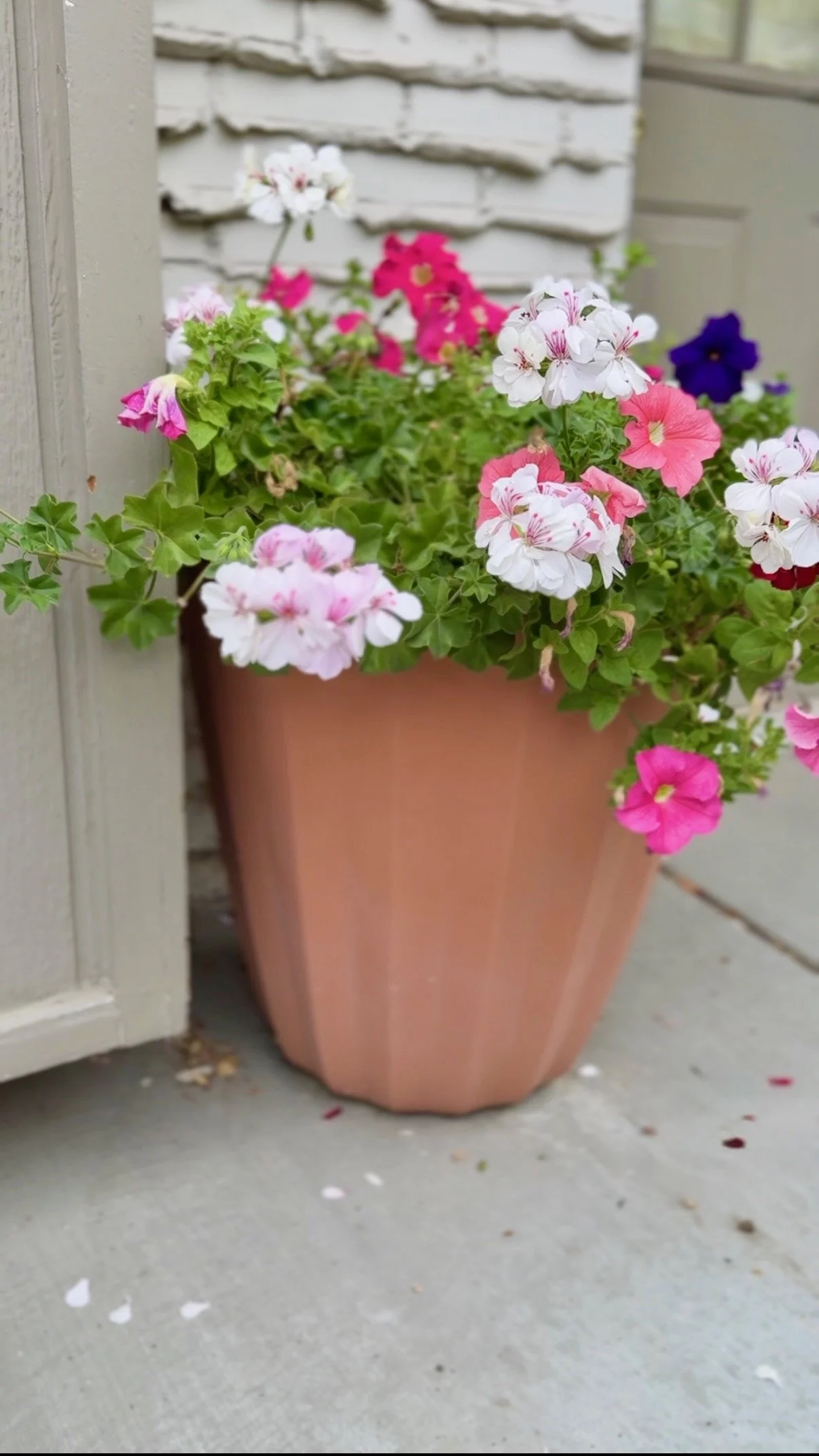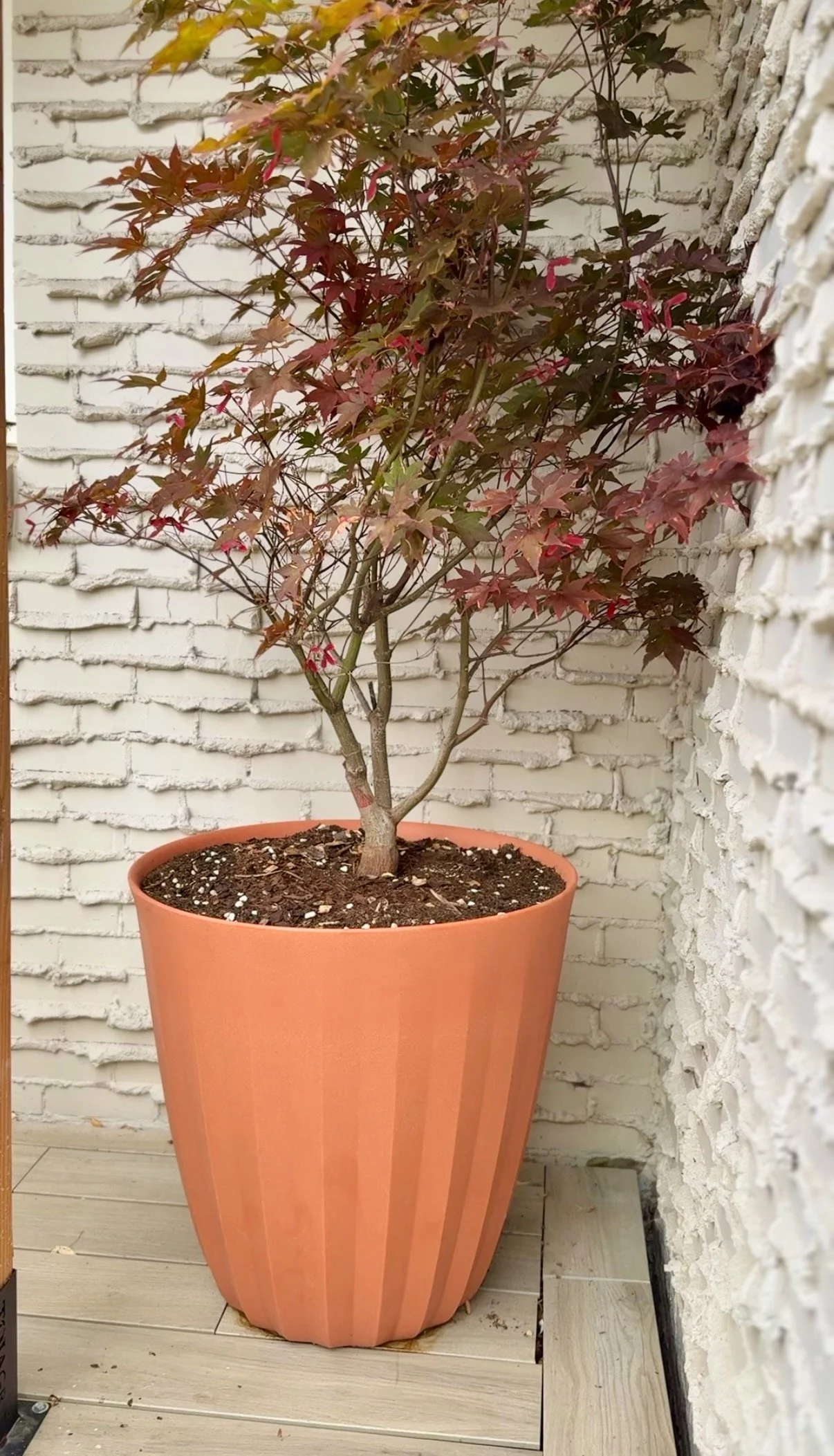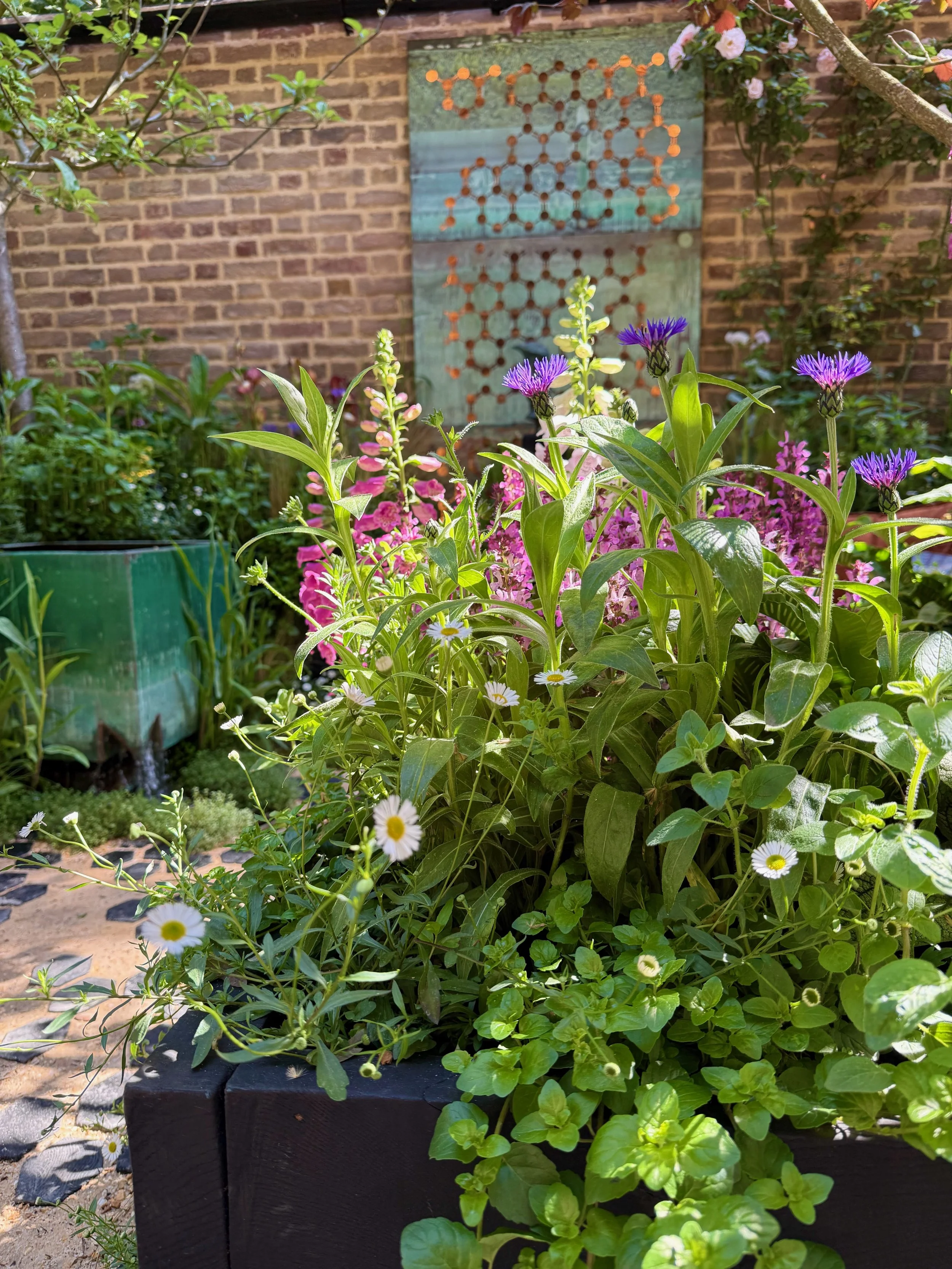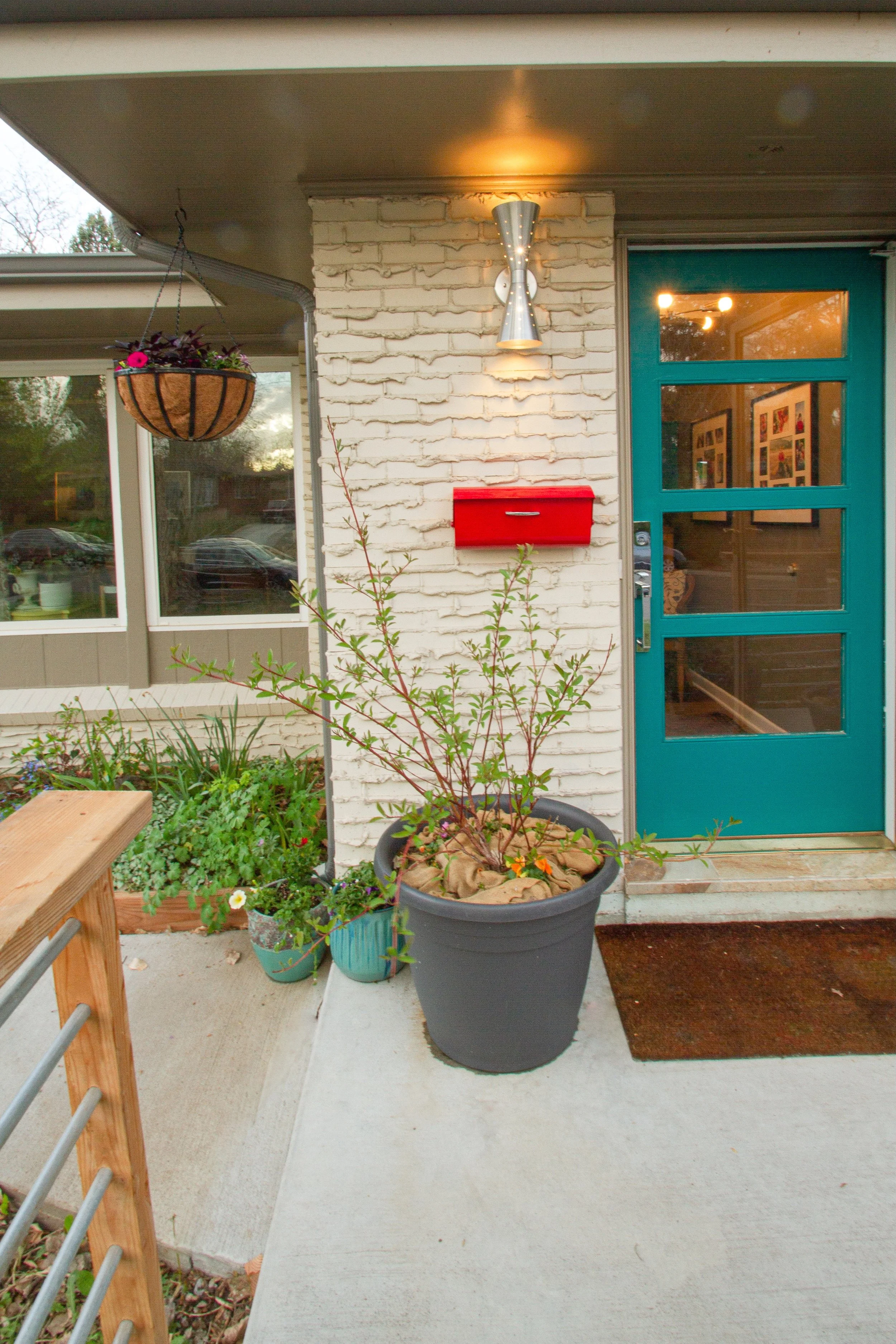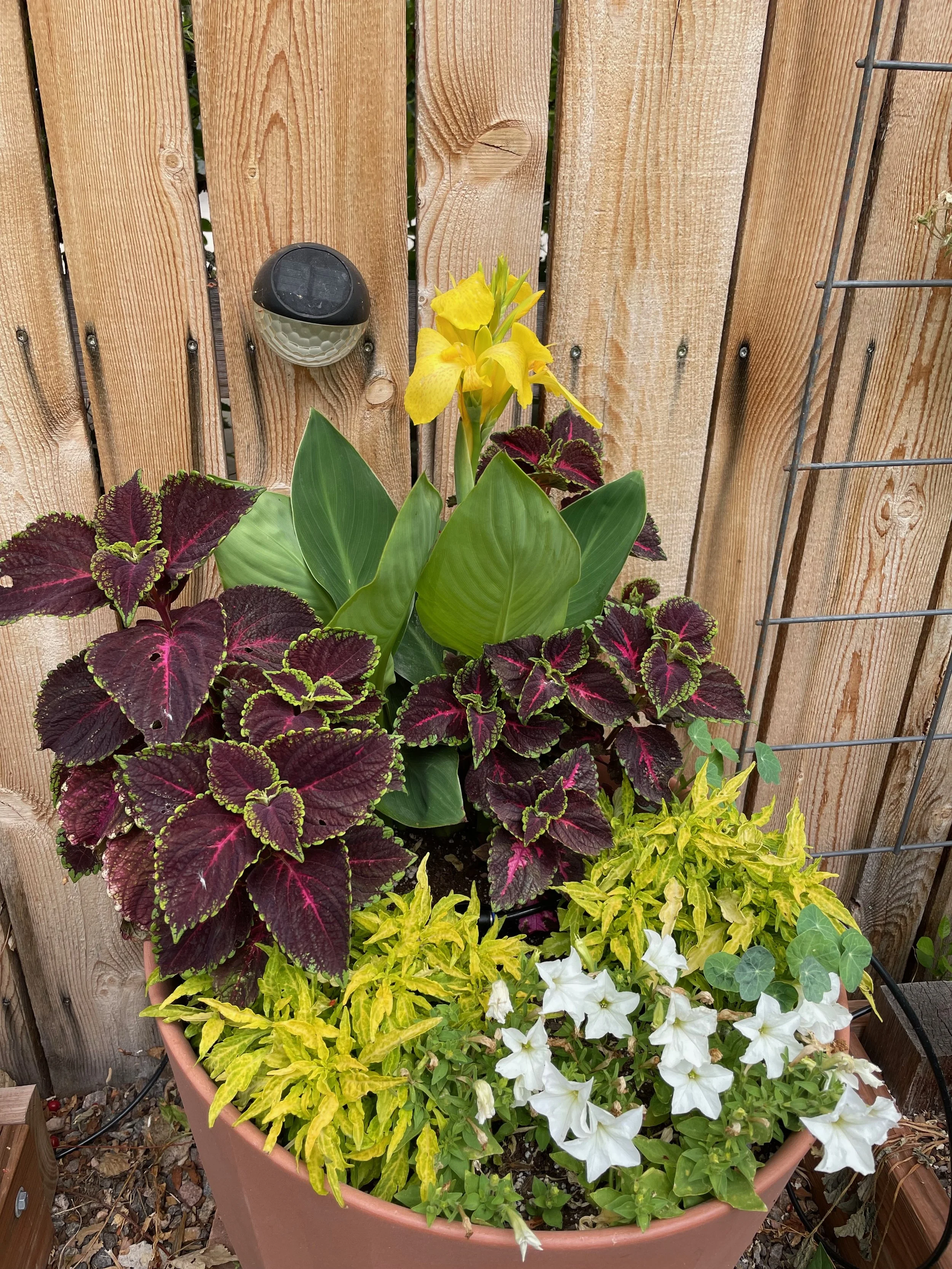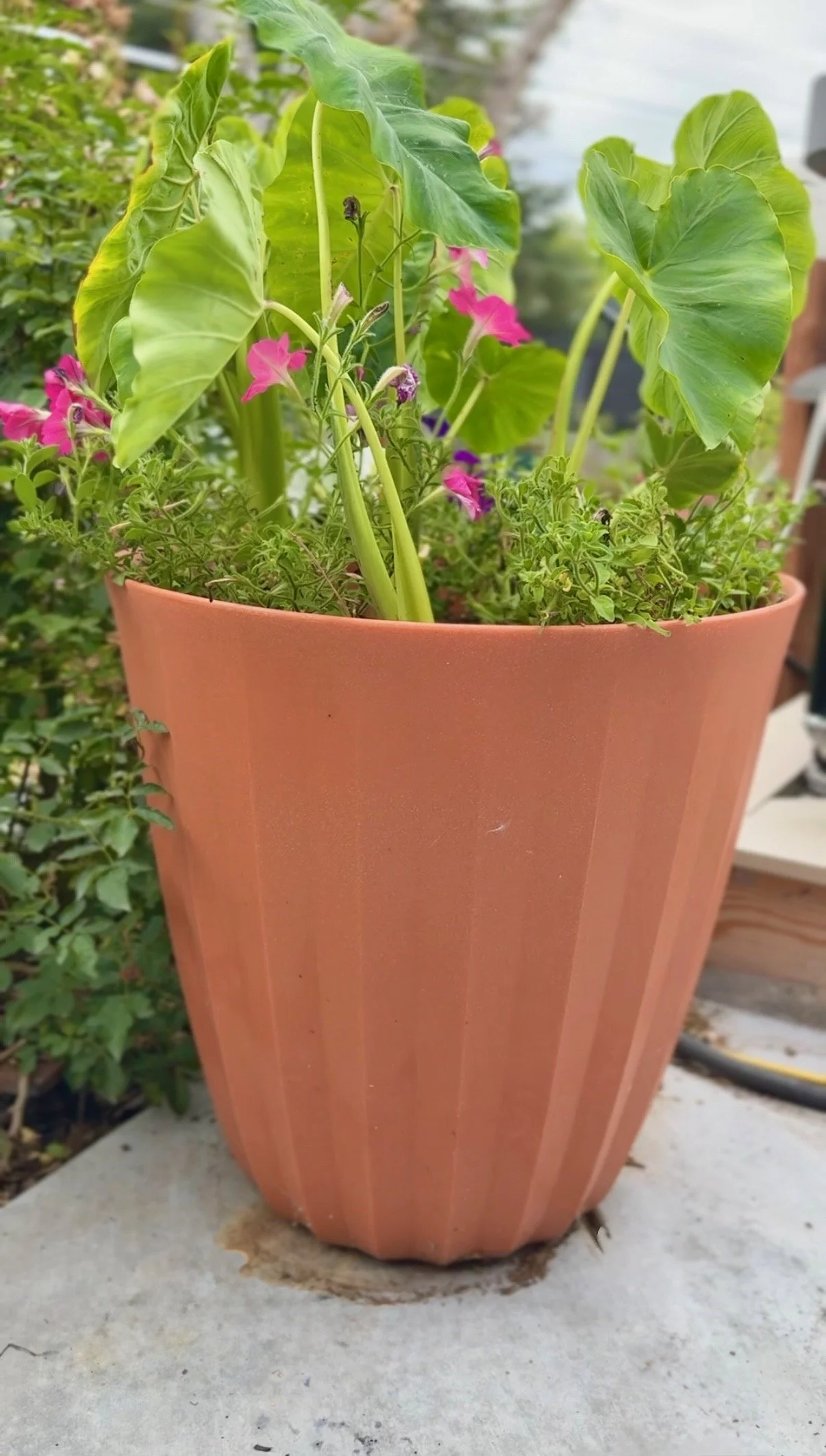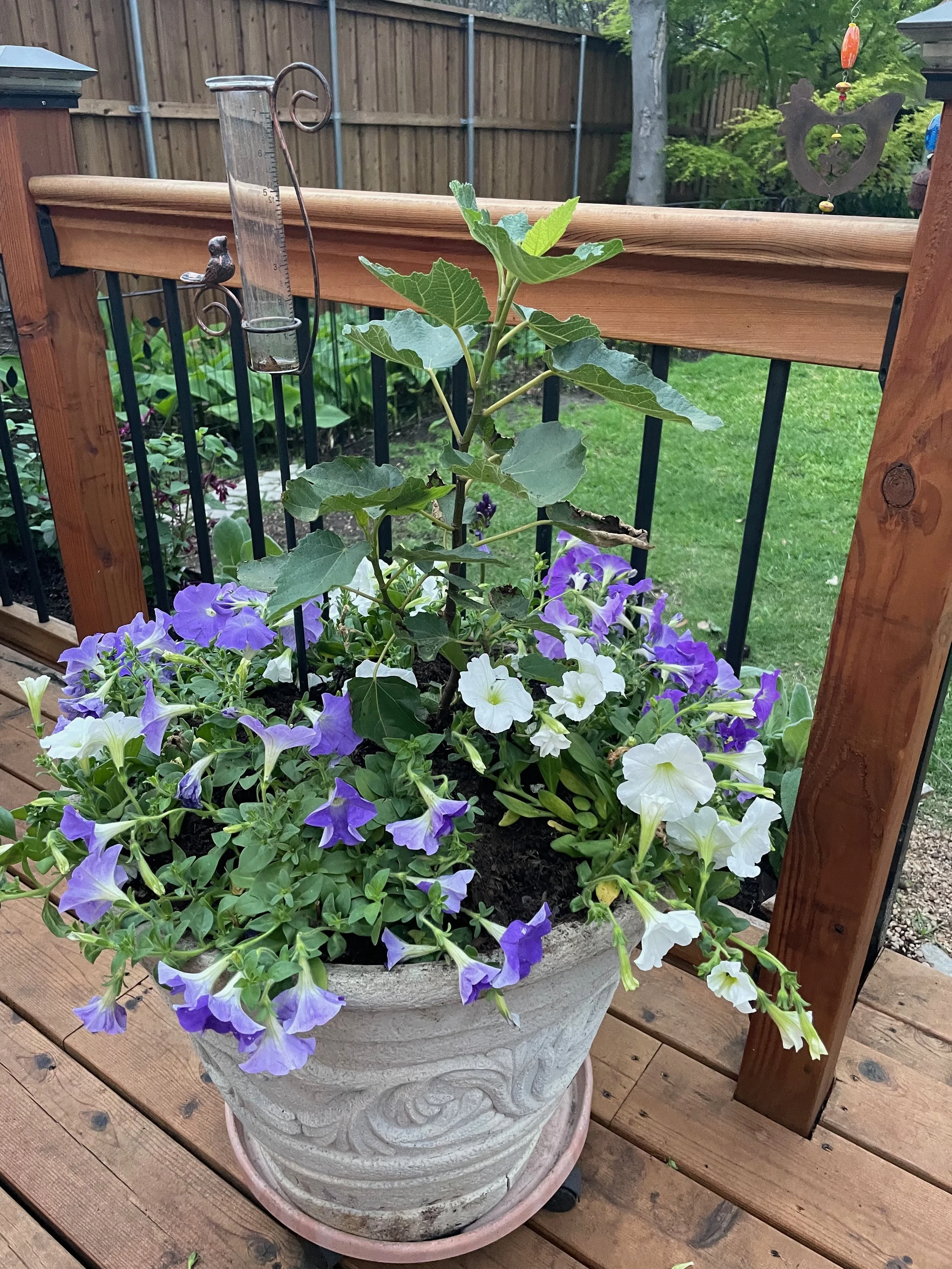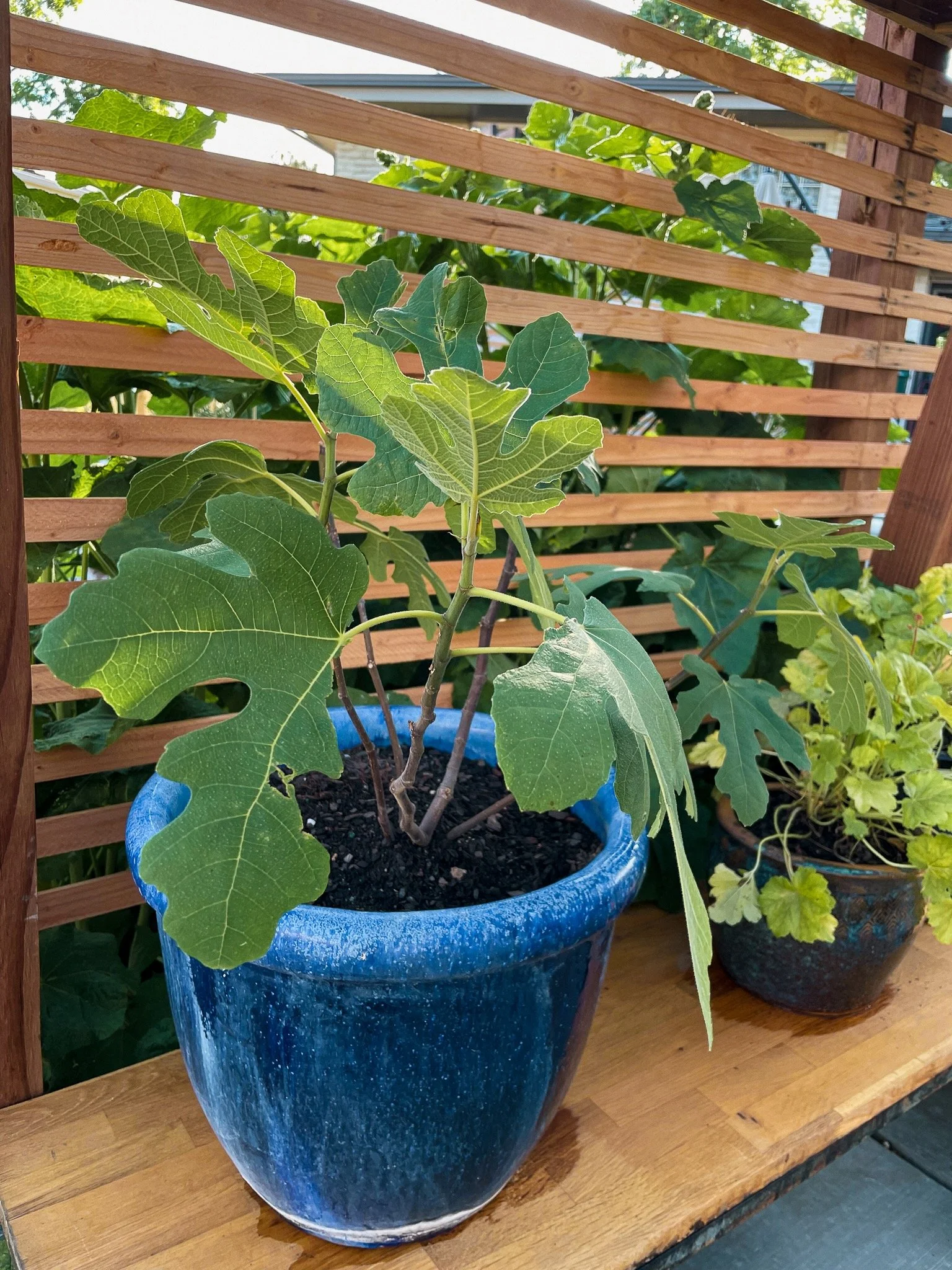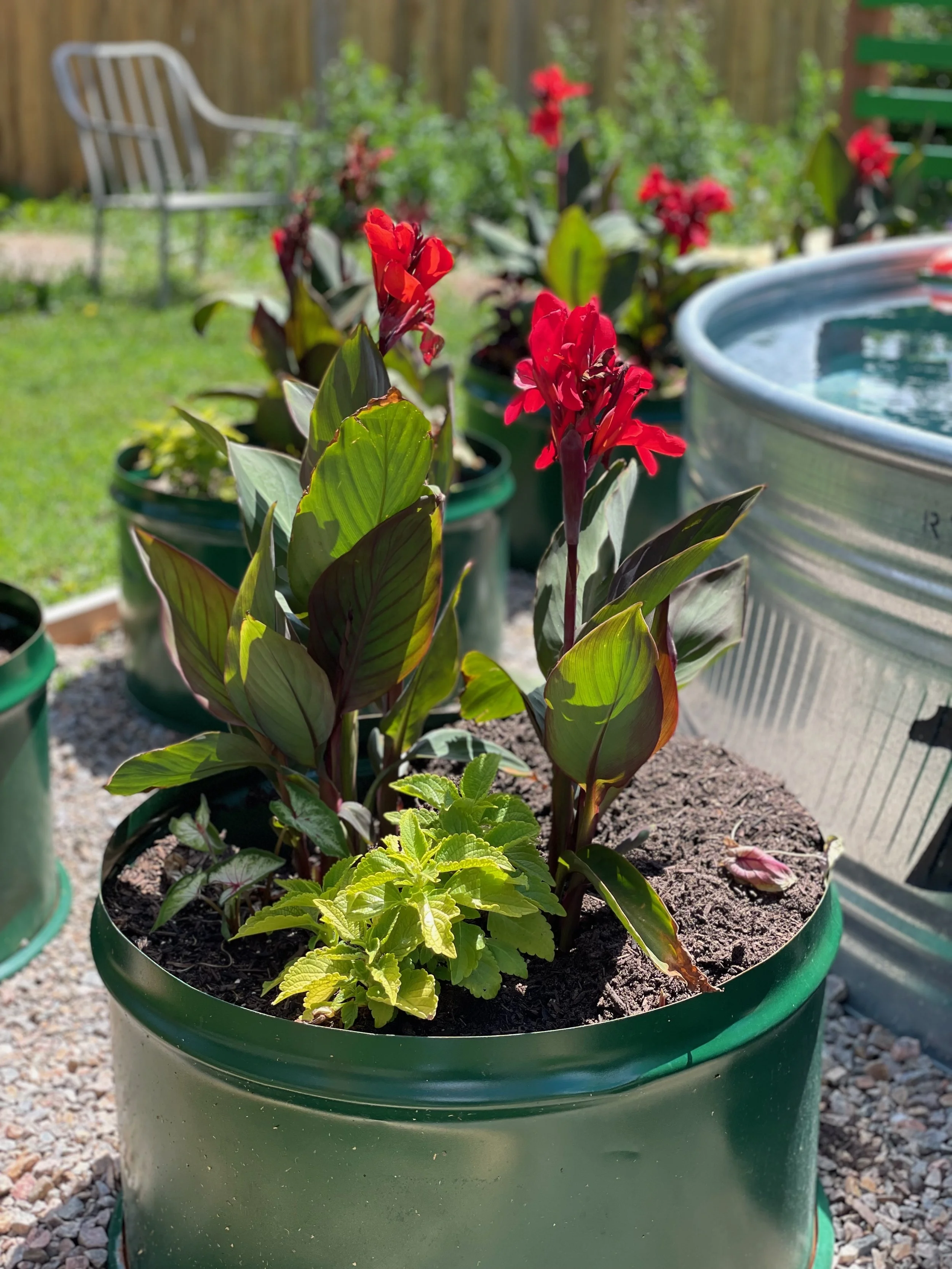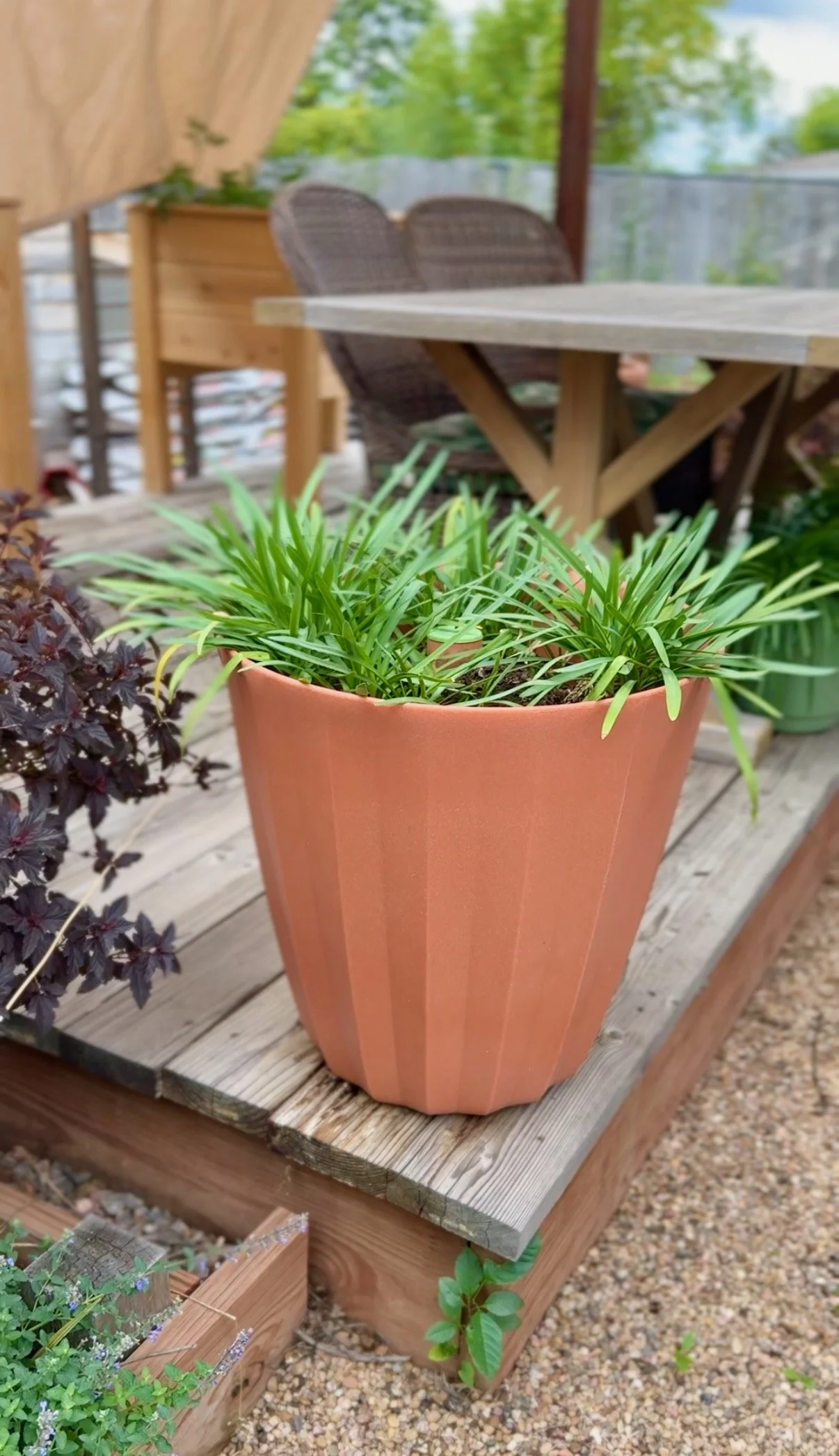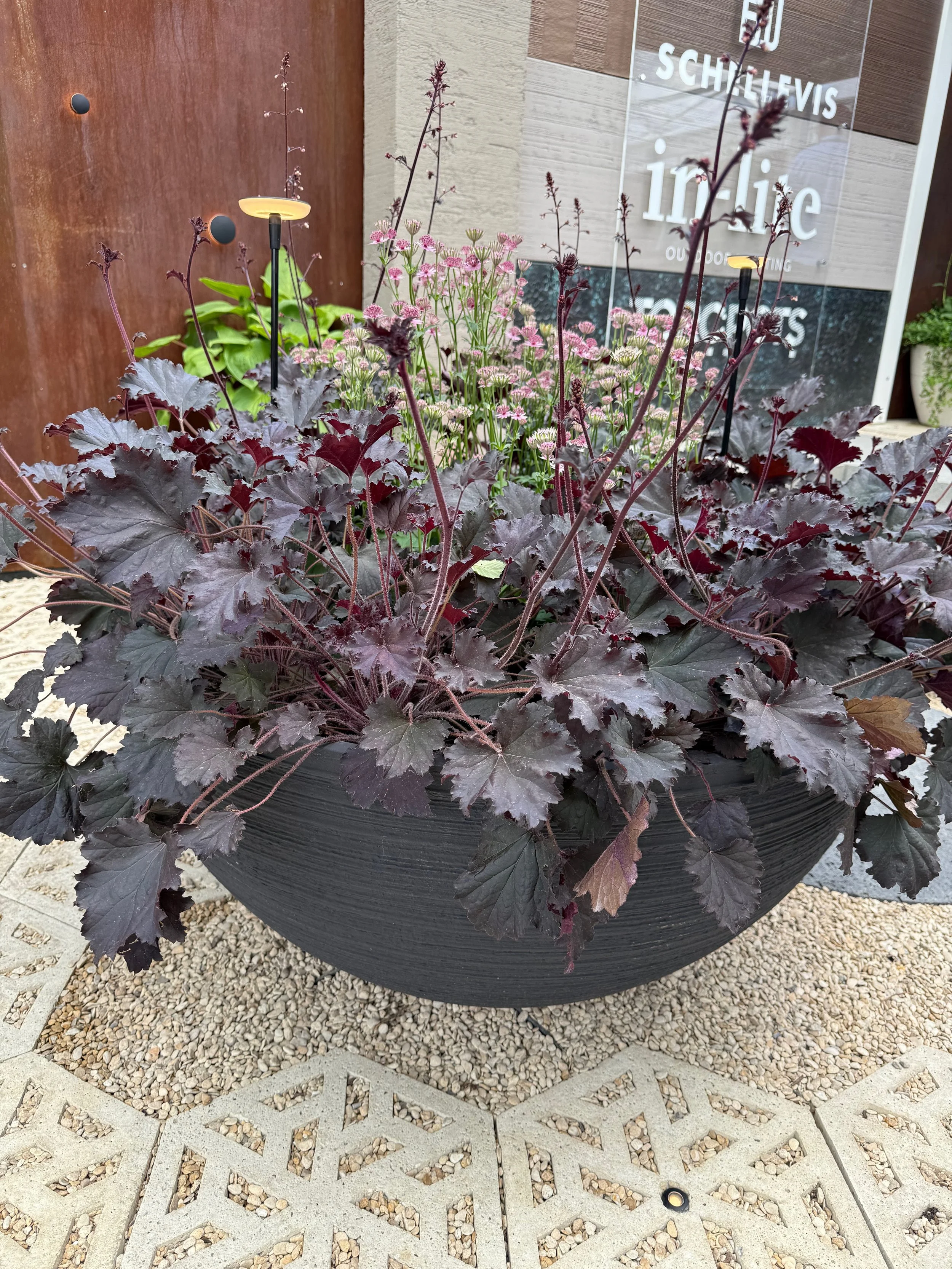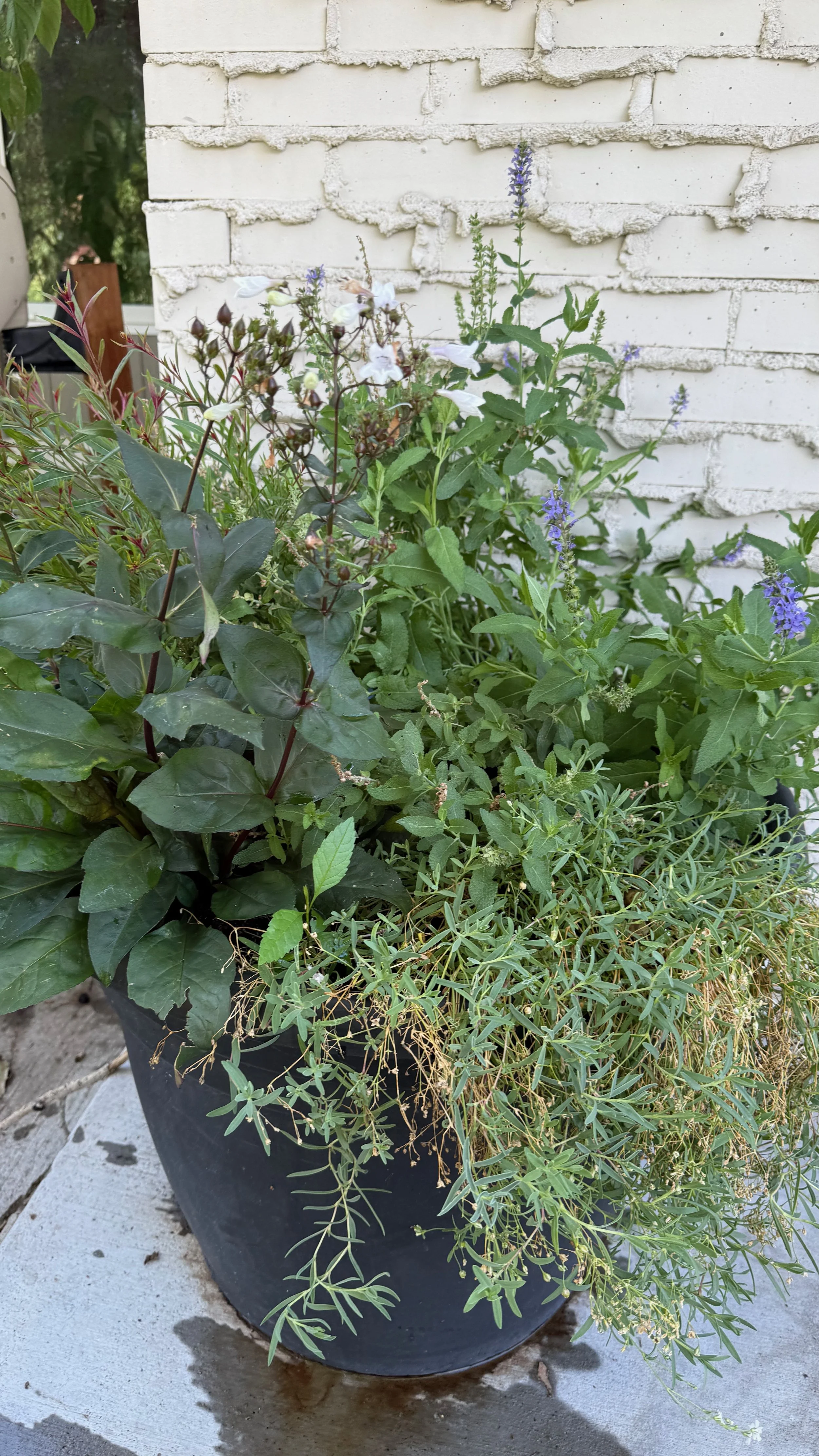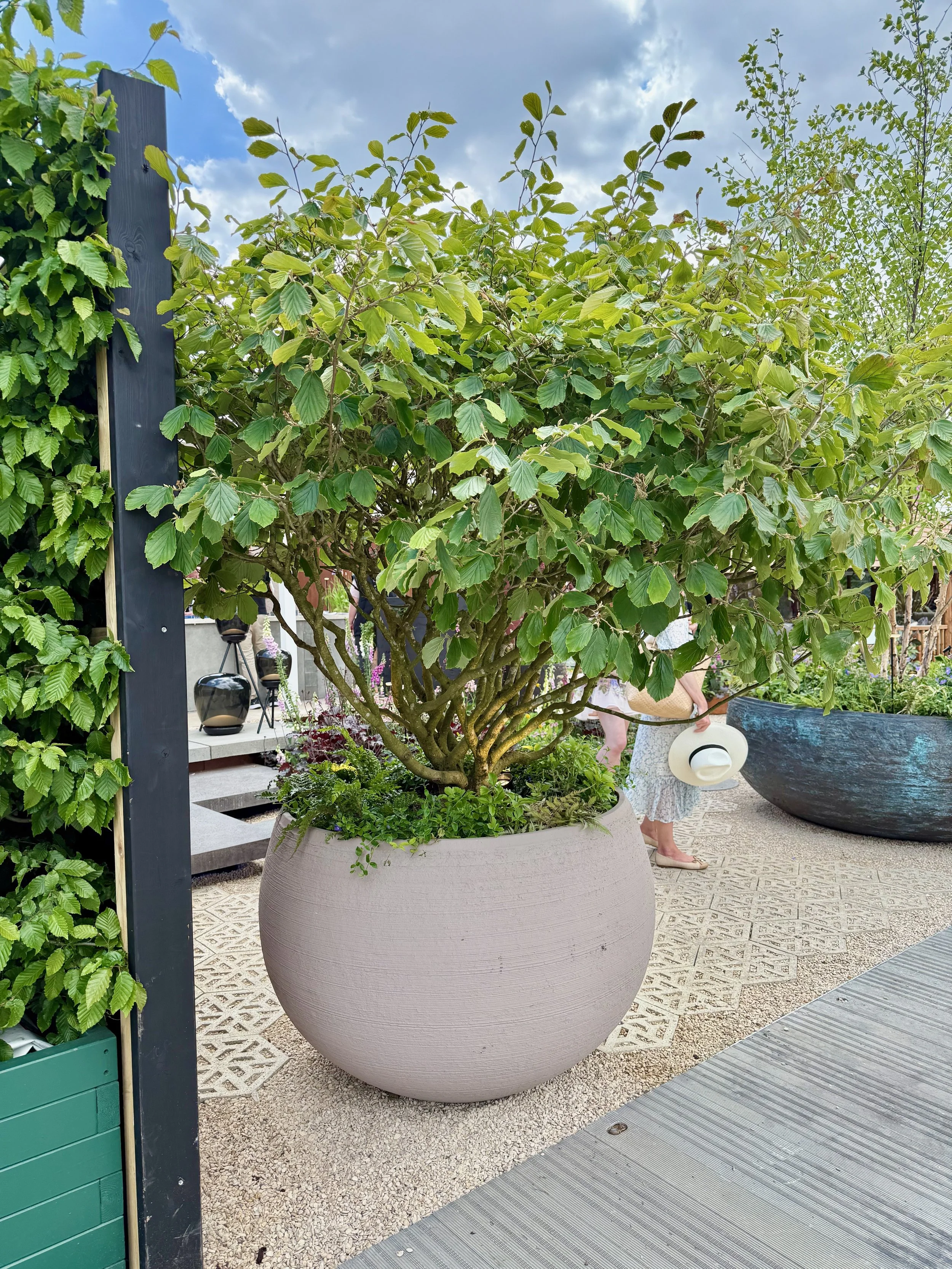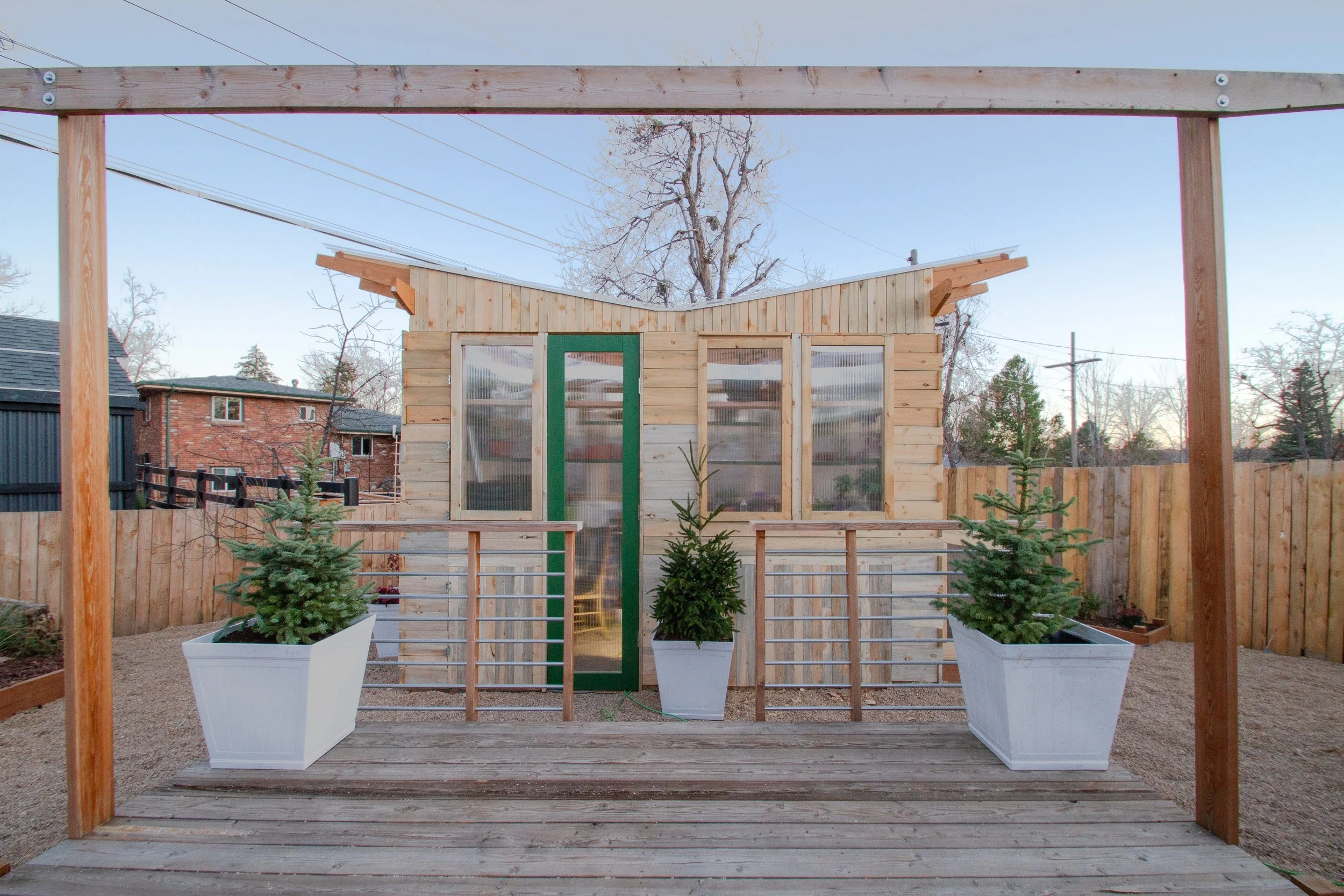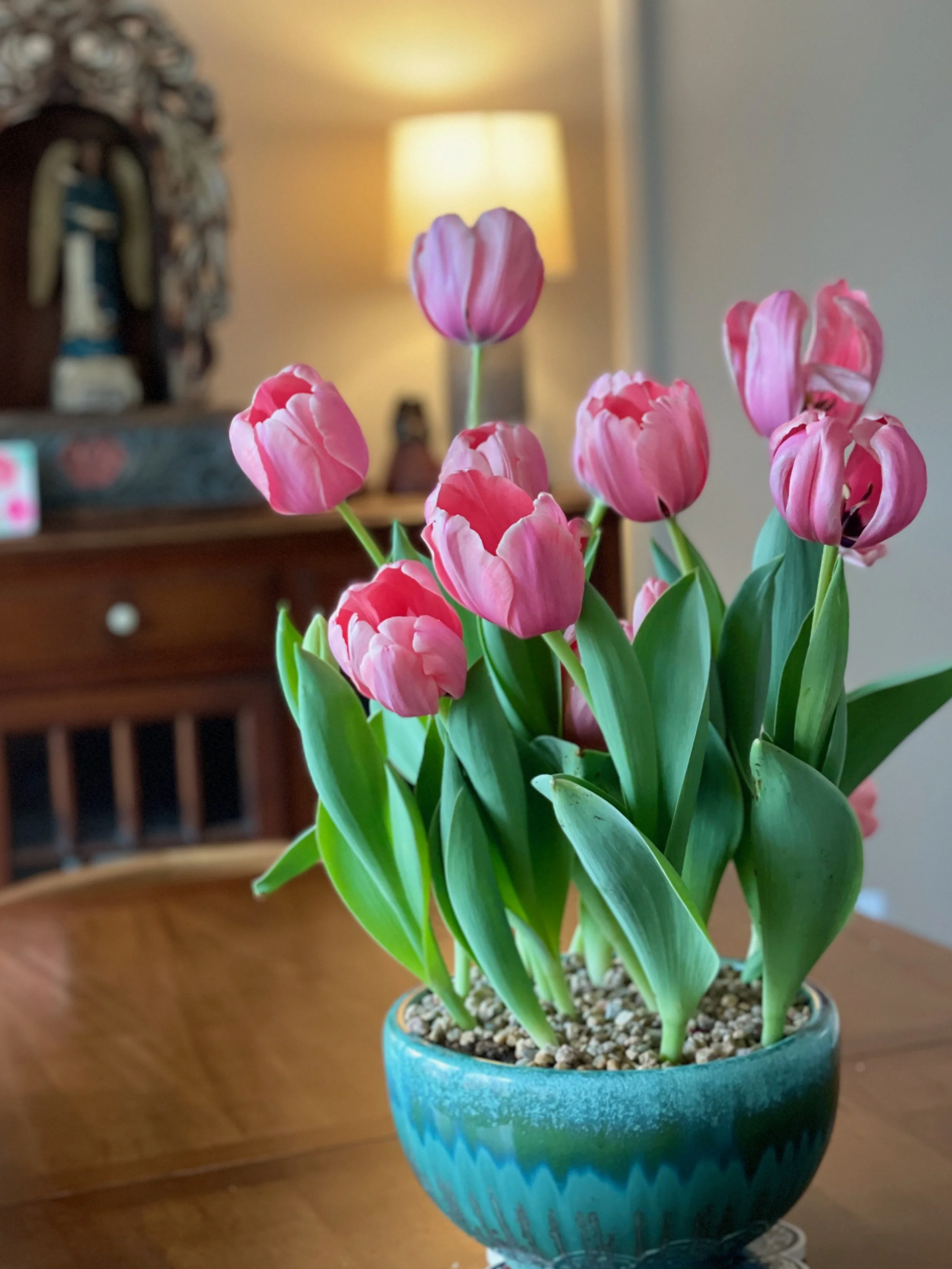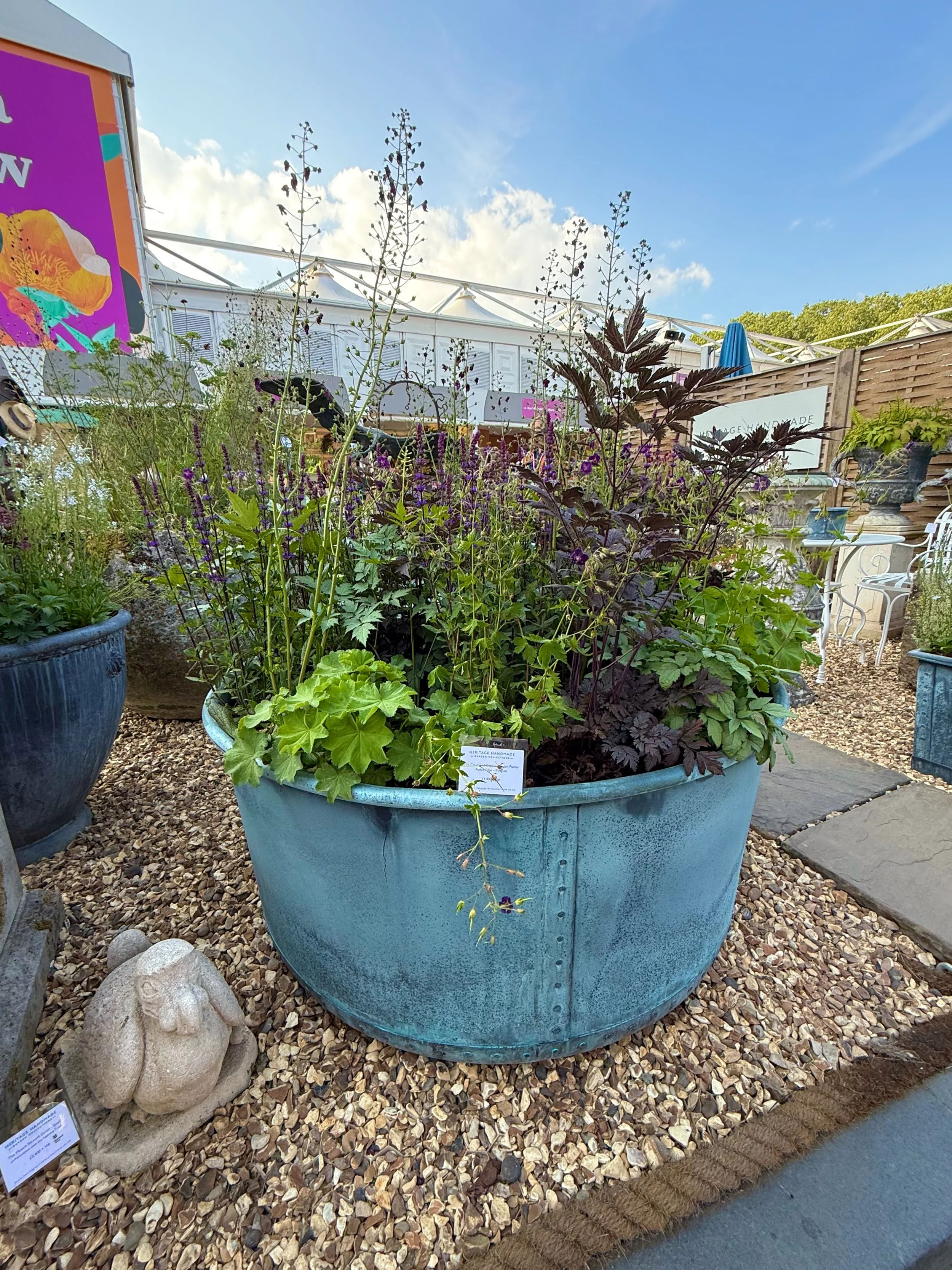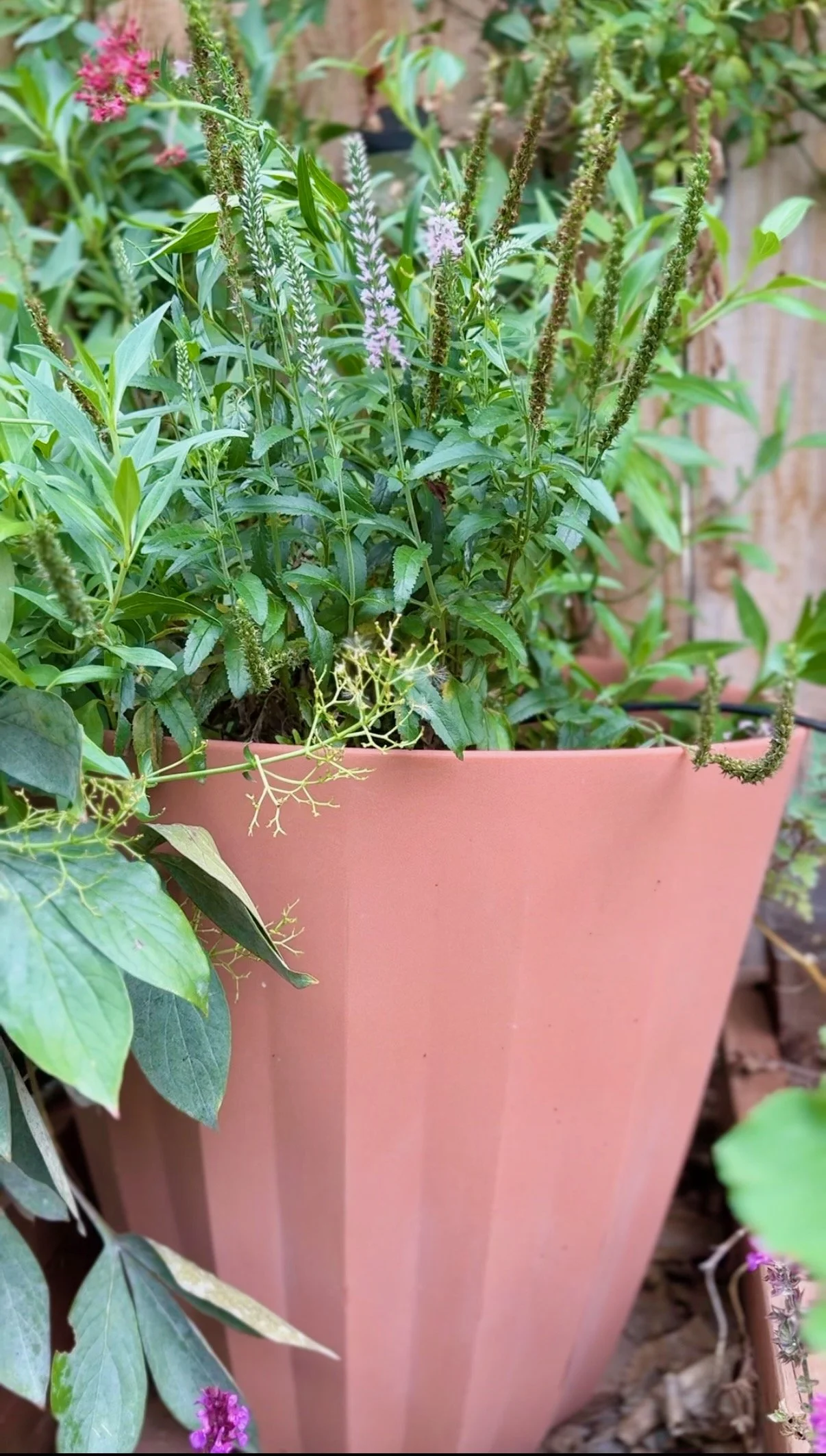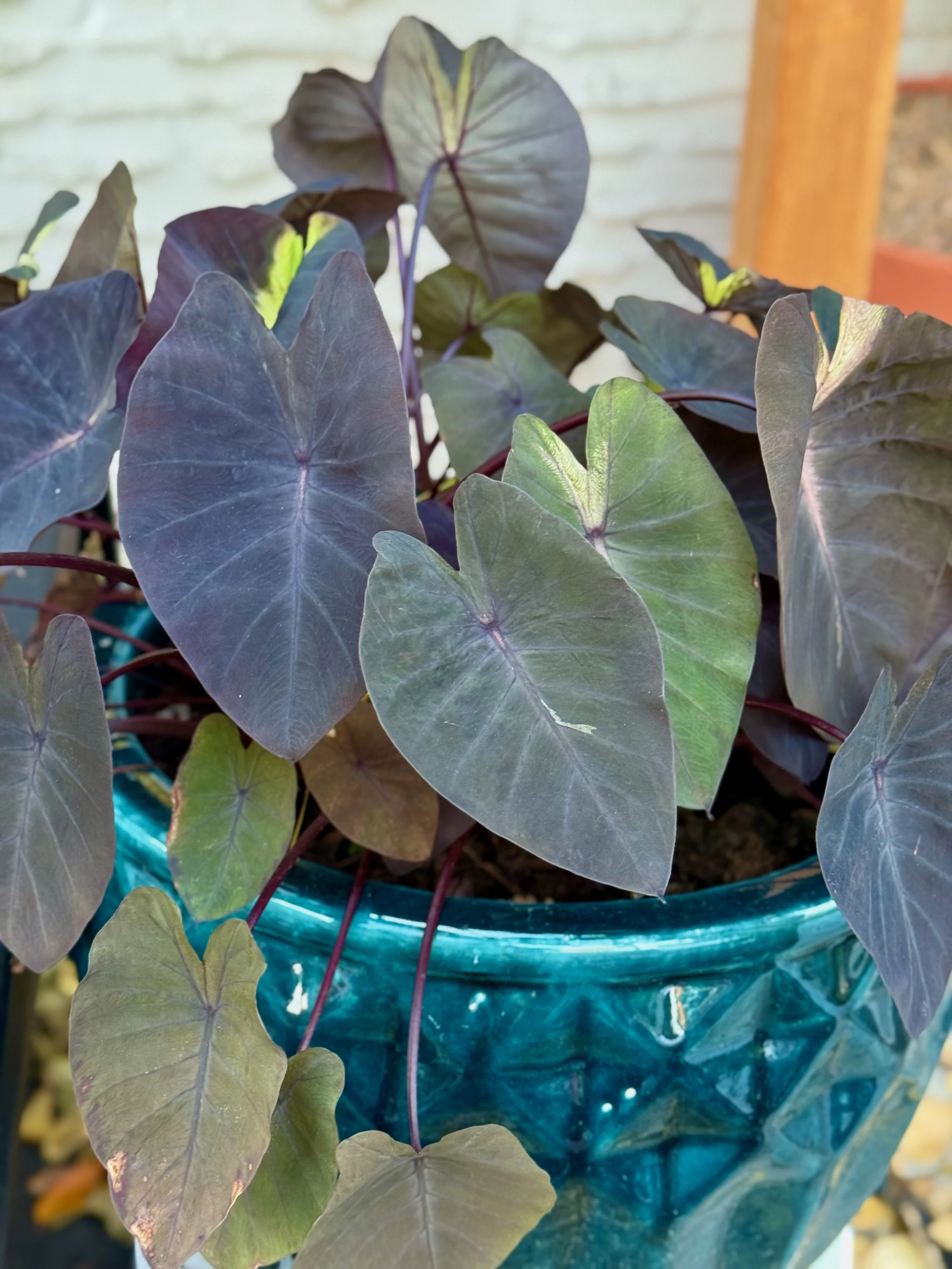Pots & Containers
for Every Season
Salvia (variety unknown) planted with Lysimachia nummularia 'Aurea' | Creeping Jenny — both are perennial here in Colorado. The Caladiums are not hardy here, but they can be kept in a greenhouse over the winter.
I love gardening in containers! Over the years, I have lived in several places where container gardening was the only option, frankly, which spurred me to embrace containers early on. In our current home, I have pots and containers large and small – both on our deck in the back and at the front door, and I change out the plantings seasonally to dress up our home.
But I have a trick: I almost always fill these containers with perennials which I then plant out into the landscape as the seasons change.
There are some amazing advantages to doing this – and it saves me money in the long run.
Cornus sericea | Red Twig Dogwood underplanted with Pansies which are often sold as annuals here in Colorado, but they are actually perennial if in a sunny enough position.
Buying Perennials for Containers
When you're shopping at your local garden center, perennials tend to be more expensive. And when you're thinking about filling outside pots you might naturally skip over them. However, this is a mistake! Annuals only live for one season, but perennials live for multiple seasons (brush up on the differences here). When you put perennials in a pot or other container for a seasonal display, you then can plant them out into the landscape and get the full impact of that plant for years to come.
And this actually has several advantages:
Save Money: over the long-term, it's actually cheaper to fill your pots with perennials if you plant them into your beds and borders afterwards.
Extra Pampering: I think of the time that my perennials are living in containers a bit like a spa treatment. They get a little extra water and a few months of care during which they get bigger and develop even more roots. Then when they are planted out into the garden, they are very happy and healthy and ready to romp.
Build your Plant Stock: in other words, you're getting more plants. Sometimes when it's time to plant out your perennials, they can also be divided. After a summer of pampering, for example, you might have two or three plants ready to stick in the ground instead of one. So you can easily build up the quantity of high-quality plants in your garden over time.
What Plants to Choose for your Containers
When I am choosing plants for my pots and other containers, I take several things into consideration:
Water Needs: container plants tend to need more water. If I'm using a self-watering container, I can plant thirstier plants like Elephant Ears and Coleus. If I am using ollas, I can choose larger plants because the ollas will keep water at the roots. And if I am hand-watering, I want plants that can go a few days or longer between waterings like Asparagus Ferns.
Exposure: will my pots and containers be in full sun like on my front porch? Then the plants need to be able to take the heat and sun exposure all afternoon. If they are destined for the Shade House, they will be more sheltered and protected and can be a little daintier.
Volume of the Container: bigger is better. The bigger the container, the more plants it can support for longer. That's partly a function of how often you water your containers, too!
Duration in the Container: how often will you change things up? Some plants will be happier planted out after 2-3 months. Others will thrive for 6 months or longer in a container.
Future Destination: where will these new plants live after they have spent time in the containers? Will they be planted out in the landscape? Will I overwinter them in the Greenhouse? Or will they come inside? Because I have very limited space, I tend to choose plants that will be planted out in my beds and borders – or which can be overwintered in small spaces like Elephant Ear bulbs.
Read on for a list of suggested plants!
A Quick Switch
from Summer to Winter
I bought these Cornus sericea | Red Twig Dogwood in the fall, put Christmas greenery around them for the holidays. Then I underplanted them with pansies in the spring and when they were fully leafed out for summer, I transplanted them into one of my raised beds.
When to Switch Things Up
Honestly, this is a factor of your time and finances. You could change up your containers every few months, seasonally, less or more often. For me, I've decided the right combination is to plant up containers in April/May and in October. I always aspire to create spring bulb containers in March, but most years that doesn't happen. However, it is GLORIOUS when it does!
I plant up spring/summer containers in late-April or early-May with plants I know will thrive all summer. In my larger containers, I also include ollas to help keep the containers well-hydrated and to reduce the time I have to spend watering.
If you want to switch things up frequently, here are some ideas:
Early Spring: densely-packed pots of daffodils and tulips
Late Spring/Early Summer: early summer blooms like Salvias and roses
Late Summer: refresh with varieties of Rudbeckia and grasses
Autumn: tall grasses with height and volume
Winter: evergreen shrubs surrounded by smaller evergreen foliage
Obviously, adjust those timeframes to your own climate and growing zones. Here in Colorado, our nights are still chilly enough into the first part of May that I have to be careful what is in a pot until later in the season. But in other parts of the continent, that's not a risk, and you can plant things out earlier.
The big goal is to choose plants that will enjoy their vacation in your container garden before being planted out into the landscape.
Overwintering Perennials in Pots
If you live in a warmer place where winters aren't as cold or perhaps you rarely freeze, if ever, then plant perennials in containers to live there forever! Choose containers that have good volume for long term success. And you may need to repot your plants every 2-3 years as they exhaust their potting soil. But many (not all) perennials can be very happy in containers for a long life.
If you are going to try to overwinter perennials in pots in colder places, buy plants that are happy 2 zones below your own. So if you garden in zone 6, choose plants that are hardy to Zone 4. The soil in pots will get colder and will freeze longer and harder than soil in the ground. So this can help to protect your plants. If the cold tends to come in snaps, move those containers inside or to a garage for a few days of protection until the temperatures return to your winter "normal."
Tips for Potting Up Perennials
Choose the Right Container
Use pots with good drainage holes. This is so important!
Size up just enough — don't overpot; 1–2" wider than the root balls is ideal.
For larger containers: don't be afraid to put in multiple plants. Just water well!
Use containers suited to the season (e.g., frost-proof in winter).
Use a Quality, Peat-Free Potting Mix
Choose a well-draining, peat-free potting mix, not garden soil.
You can amend with a little grit or perlite for extra drainage, especially for alpine or drought-tolerant plants.
Consider using an Olla or a Self-Watering Planter
Ollas reduce the amount of watering you'll need to do by keeping water at the plant's roots.
Self-watering planters work on the same principle with a reservoir of water that keeps the soil consistently moist.
These are particularly helpful when you might be traveling or when placed in a sunny location without shelter.
Plant at the Right Depth
Keep the crown at soil level.
Avoid burying the base of stems which can lead to rot.
Keep the soil level at least an inch below the rim of the pot or container so that the soil doesn't wash out when watering.
Water Thoroughly After Potting
Soak the root ball before planting if it’s dry.
Water in well after potting to eliminate air pockets.
Cover Soil with Pea Gravel
I like using pea gravel in my containers because it keeps the soil from floating and washing away when I water. It also looks great!
Fertilize Lightly
In the first few months, your plants won't need much additional nutrition, but their resources can be depleted relatively quickly as pots have finite resources.
Choose organic solutions. I like a seaweed feed or an all-purpose tomato feed in the summer for my plants. Once every 2 weeks works well.
Protect in Extreme Weather
Cluster pots together in winter for a little more insulation.
Gather pots against a wall (south-facing is ideal) for wind protection.
Elevate pots on feet to prevent waterlogging.
Consider wrapping pots or moving them to a sheltered spot during freezes if you are in a mild climate, or move them into a garage for shelter.
Tips for Dividing Potted Perennials
(After a Few Months)
Timing Matters
Spring or fall is ideal for division (cooler, moist conditions).
Avoid dividing in high summer unless you're really diligent about watering.
Use Clean, Sharp Tools
Use a knife, hori-hori, or spade to divide large clumps.
For fibrous-rooted perennials (like daylilies or hostas), you may need to cut through the crown.
Keep Divisions Healthy
Each division should have several shoots and a healthy root system.
Remove dead or mushy sections before replanting.
Replant or Repot Promptly
Replant divisions in the ground or into fresh potting mix in new pots.
Water thoroughly and keep moist until re-established.
Give Them a Recovery Period
Shade them temporarily if it's hot or sunny.
Avoid fertilizing immediately — let them settle first.
Perennials for Every Season
Perennials for
Winter Containers
These offer evergreen structure, interesting texture, or winter color — and handle cold weather well in pots. Some of these suggestions are great for moderate climates. For those of you who, like me, get pretty severe winters, evergreens are the way to go!
Heuchera (Coral Bells) | Evergreen foliage in vibrant colors (purples, ambers, limes); holds up well in cold.
Carex (Sedge) | Evergreen or semi-evergreen grasses add texture and motion.
Helleborus (Lenten Rose) | Winter blooms and glossy foliage; very hardy.
Bergenia | Large glossy leaves that often turn red or bronze in cold; early spring flowers.
Festuca glauca (Blue Fescue) | Striking blue grass for structure and color.
Ajuga (Bugleweed) | Groundcover with colorful foliage; evergreen in many climates.
Cyclamen coum | Hardy species bloom in late winter with delicate flowers over marbled leaves.
Iberis sempervirens (Evergreen Candytuft) | Compact, low-growing with shiny green foliage and spring bloom.
Mugo pine, Pinus mugo mugo | Evergreen with mounding shape
Globe blue spruce, Picea pugens ‘Glauca Globosa’ | Beautiful evergreen spruce that can be shaped into topiary-like shapes
Dwarf Alberta spruce | Evergreen with a Christmas tree look
Korean boxwood, Buxus koreana | Evergreen with small leaves that can be shaped
Japanese boxwood, Buxus japonica | Evergreen with small leaves that can be shaped
Holly, Ilex ‘Jersey Male’ | Holly shrub that is slow-growing and can be pruned
Ilex crenata ‘Sky Pencil’ | Tall and thin evergreen; modern shape
Perennials for
Spring Containers
These bring early color and freshness; some may even start in late winter and transition beautifully into the season. Keep frost cloth on hand for deep freezes with these plants, but they are hardy in many areas.
Primula (Primrose) | Bright, cheerful blooms; many varieties tolerate chill well.
Pulmonaria (Lungwort) | Silver-spotted leaves and early blooms in pinks, blues, or purples.
Brunnera macrophylla (Siberian Bugloss) | Heart-shaped, often variegated leaves and forget-me-not-like flowers.
Dicentra spectabilis (Bleeding Heart) | Graceful arching stems with dangling heart-shaped blooms.
Aquilegia (Columbine) | Airy, nodding flowers with unique shapes; early season interest.
Tiarella (Foamflower) | Delicate spikes of bloom and pretty foliage — great for shade containers.
Veronica (Speedwell) | Upright bloom spikes add vertical interest.
Geum | Cheerful blooms in red, orange, or yellow with a long bloom window.
Need more ideas for designing your garden? Check out this post:
These plants bring strong late-season color and texture, and often provide winter interest too.
Aster | Fall-blooming varieties are vibrant in pinks, blues, and purples.
Rudbeckia (Black-Eyed Susan) | Bold golden flowers with dark centers; classic late-season star.
Heuchera | Foliage stays showy all year, especially rich in fall hues.
Sedum 'Autumn Joy' | Thick foliage and dusky pink flower heads maturing to bronze.
Eupatorium (Joe Pye Weed) | Tall, architectural, with mauve-pink blooms in early fall.
Calamagrostis (Feather Reed Grass) | Elegant grass with feathery plumes.
Hylotelephium (Tall Sedum) | Excellent structural form and autumn interest.
Anemone hupehensis (Japanese Anemone) | Graceful blooms on tall stems into late fall.
Perennials for
Summer Containers
Choose heat-tolerant, floriferous perennials that hold up well through hot weather in pots.
Salvia nemorosa | Long bloomers with spikes of purple, pink, or blue.
Echinacea (Coneflower) | Bold, daisy-like flowers and upright growth.
Gaillardia (Blanket Flower) | Hot-colored blooms all summer long.
Coreopsis | Low-maintenance daisy-like blooms; thrives in containers.
Nepeta (Catmint) | Mounded habit, gray-green foliage, and soft blue flowers.
Sedum (Stonecrop) | Drought-tolerant, with fleshy leaves and late-summer flowers.
Agastache (Hyssop) | Fragrant foliage and long-blooming spires attractive to pollinators.
Penstemon | Spiky blooms in a wide range of colors, attractive to hummingbirds.
Perennials for
Fall Containers
at the close…
I am all about saving money AND creating a beautiful home and garden. Using perennials as much as possible has been a key part of making those things happen at my house.
And there is an environmentally-responsible aspect to all of this, too. Producing plants for purchase is labor and resource intensive. So choosing them so that they last longer, live out their life cycles, and fill multiple purposes — that is a more responsible path.
So try potting up some perennials this season — and using them in more than one way. You may be very surprised at how easy and gratifying it is!
Happy Gardening!
Angela
Subscribe now so you never miss a thing!


